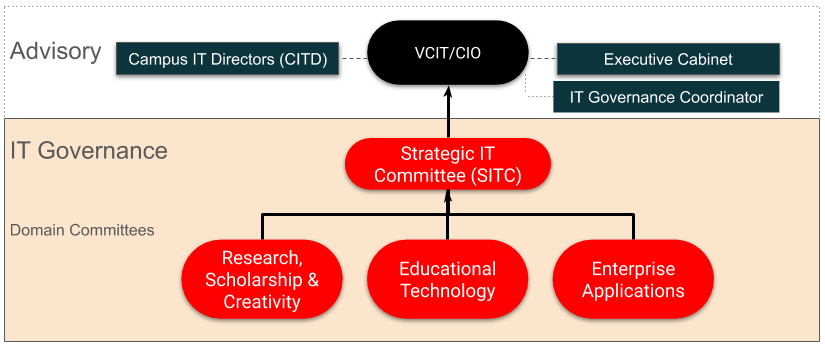IT Governance
The overarching role of IT governance is to provide strategic oversight and guidance around IT matters. It provides the framework for processes and structures that ensures the effective and efficient use of IT.
Significant goals of the current IT governance structure include:
- Better aligning IT infrastructure and services with the university’s mission and business
- Improving efficiency
- Differentiating the work of operational and advisory groups from the governance-related structure
Committees
- Strategic IT Committee
- Educational Technology Committee
- Enterprise Applications Committee
- Research, Scholarship and Creativity IT Committee
Structure
The diagram below shows the current IT governance model and reporting structure.

Description of Structure
The IT governance structure has a Strategic IT Committee (SITC) that advises the vice chancellor for information technology and chief information officer (VCIT/CIO), who in turn consults with the Executive Cabinet.
Under the SITC are three domain committees which operate independently but also advise the SITC. These committees are the Educational Technology Committee, Enterprise Applications Committee and Research, Scholarship and Creativity IT Committee. These committees can appoint steering teams or working groups as needed to help them carry out their work.
The chief information security officer is a member of the SITC, and IT Security is represented on each of the domain committees. The Campus IT Directors serve as a significant advisory group to the VCIT/CIO and the SITC.
If you have questions about NC State’s IT governance process, please contact the IT Governance Coordinator.
Non-Governance IT Groups
Non-governance groups serve a critically important role in assisting the service owners and the CIO, who is ultimately accountable for IT service delivery. In general, these groups fall into two categories: advisory groups and service teams. They serve to assist the service owner and to allow stakeholders to have direct input on decisions affecting the service. The Campus IT Directors serve as a major advisory group for both the vice chancellor for IT and many service owners. There are also other advisory and steering teams that play significant roles in the functioning of IT services.
Background of the Current Structure
The most recent changes to the IT governance structure resulted from a study spawned by the university’s IT Strategic Plan. See the NC State IT Governance Redesign final report for more details.
This governance structure is evaluated on a regular basis, typically as part of an annual review the CIO has with the committee chairs.
Advisory Groups and Steering Teams
Though not part of the formal IT governance structure, there are a number of advisory groups and steering teams that play a critical role in providing guidance and operational directions for campus IT services.